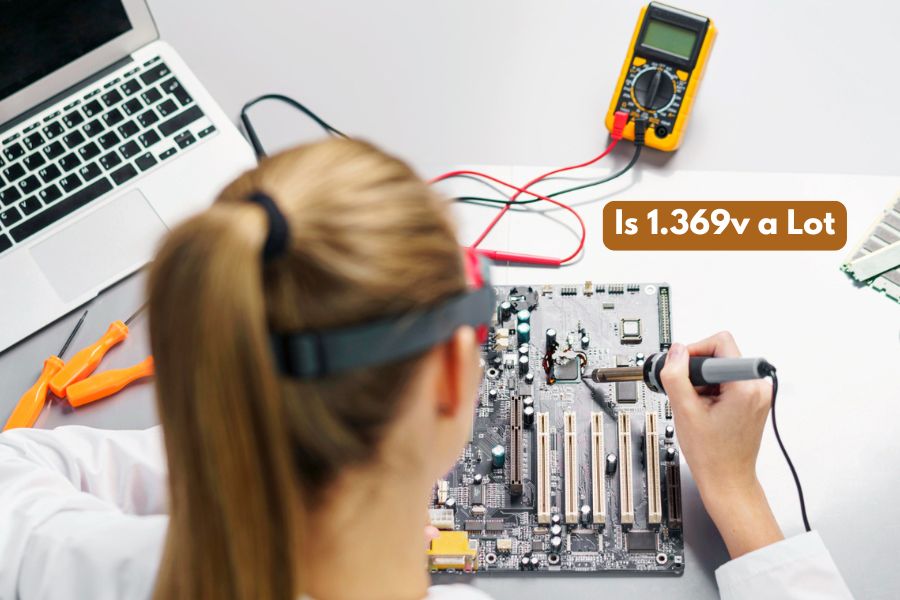When working with electronics, understanding voltage levels is essential to ensure components and circuits function correctly. Whether you’re assembling a computer, working on a DIY electronics project, or simply curious about the inner workings of devices, you may encounter different voltage measurements like 1.369 volts (V). You might wonder, “Is 1.369v a lot?” The short answer is: it depends. In this blog, we’ll explore what voltage is, what 1.369 volts represent, and how to interpret voltage in different contexts.
What Is Voltage?
Before diving into whether 1.369v is a lot, it’s essential to understand the basics of voltage. Voltage, also known as electric potential difference, is the force that pushes electrical charges through a circuit. It’s measured in volts (V) and is an important aspect of how electrical systems function.
How Voltage Works
Imagine electricity as water flowing through pipes. Voltage is similar to water pressure—it pushes the electrical current (equivalent to the water) through a conductor, like a wire. The higher the voltage, the more “pressure” is applied to move the current. Voltage exists between two points, and the flow of current occurs when there is a difference in electric potential between those points.
Types of Voltage
There are two main types of voltage:
- Direct Current (DC): Voltage flows in one direction.
- Alternating Current (AC): Voltage changes direction periodically.
DC is typically used in batteries and small electronic devices, while AC is what powers homes and large appliances.
Is 1.369v a Lot of Voltage?
Context Matters
Whether is 1.369v a lot considered “a lot” depends entirely on the context in which it’s being used. Voltage levels can vary widely between different devices, circuits, and applications. To determine if 1.369v is significant, you must compare it to the typical voltage range for that specific application.
Let’s look at some common voltage levels in various electronics:
1.369v in Computer Components
In modern computing, voltage levels vary significantly based on the component you’re looking at:
- CPU Voltage: Many CPUs operate at low voltages to minimize heat and energy consumption. Typical CPU core voltage (Vcore) ranges from 1.1v to 1.4v. Therefore, 1.369v would fall within the normal range for many processors, particularly during tasks like overclocking.
- Memory (RAM): RAM typically operates between 1.2v and 1.5v, depending on the type and generation. For example, DDR4 memory modules usually operate at 1.2v, while DDR3 might use 1.5v. So, 1.369v would be relatively normal for memory modules in some cases.
- Graphics Card: Graphics Processing Units (GPUs) may operate at higher voltages, but many parts of the circuit run at low voltages like 1.369v. This value could be common in the voltage regulators controlling GPU operations.
1.369v in Battery-Powered Devices
For battery-operated devices like smartphones, laptops, and portable electronics, the voltage can be a critical factor:
- Smartphones: The batteries in smartphones generally operate at 3.7v, which is much higher than 1.369v. In this context, 1.369v would be too low to power most modern mobile devices.
- Small Electronics: Devices like calculators, LED flashlights, and remote controls often use small batteries with voltages around 1.5v. In these cases, 1.369v is close to the battery’s full capacity and could be enough to power the device.
1.369v in Logic Circuits
Low-power logic circuits, such as those found in microcontrollers and sensors, often use lower voltages. Logic circuits can operate at 1.8v, 3.3v, or 5v depending on the design.
- Microcontrollers: Many microcontrollers can function at low voltages like 1.8v. A voltage of 1.369v might not be enough to drive certain digital logic circuits, but it could be close.
Is 1.369v Dangerous?
Generally speaking, 1.369 volts is not considered a dangerous level of voltage. Voltages that pose a risk of electric shock typically start above 50v. However, when it comes to sensitive electronic components, even small voltage variations can cause damage.
For example:
- Overvolting: If a component designed to run at 1.2v is exposed to 1.369v, it might get damaged due to the excess voltage. This is why it’s important to understand voltage tolerances for different parts.
- Undervolting: Conversely, a component designed to run at 1.5v might not function properly at 1.369v due to insufficient power.
Common Voltage Levels in Electronics
To give more context about 1.369v, let’s examine some common voltage levels in everyday devices:
- Household Electricity: In many countries, household power outlets provide 110v or 220v AC. Compared to this, 1.369v is very small and not suitable for powering large appliances.
- Car Batteries: Automotive batteries typically provide 12v DC. Compared to this, 1.369v would be far too low to operate most car electronics.
- AA Batteries: Standard AA batteries produce 1.5v, making 1.369v close to what you would expect from a partially discharged battery.
Why Accurate Voltage Is Important
Maintaining the correct voltage level is crucial for the efficient operation of electronic devices. Too much or too little voltage can result in malfunction or damage. Here are some key reasons why voltage accuracy matters:
- Component Safety: Exceeding voltage limits can damage sensitive electronics, leading to overheating or permanent failure.
- Energy Efficiency: Using the correct voltage ensures that devices operate efficiently, conserving energy and prolonging their lifespan.
- Performance Stability: Keeping components at the proper voltage helps maintain performance, especially for critical tasks like gaming or computing.
Measuring Voltage
How to Measure Voltage
To determine if 1.369v is the correct voltage for your device, you’ll need a multimeter. A multimeter is a tool that can measure voltage, current, and resistance. Here’s a simple guide to measuring voltage:
- Set the Multimeter: Turn the dial on your multimeter to the voltage setting (V). For DC measurements, choose a setting higher than the expected voltage (e.g., 2v for low-voltage electronics).
- Connect the Probes: Touch the positive (red) probe to the positive terminal of the component or battery and the negative (black) probe to the negative terminal.
- Read the Display: The multimeter will display the voltage reading. If the reading shows 1.369v, you can compare it to the expected voltage for your component.
Voltage Tolerance and Variability
Electronic devices often have a voltage tolerance, meaning they can operate within a certain range of voltages. For example, a CPU with a nominal voltage of 1.35v might function properly within a range of 1.3v to 1.4v. If you measure 1.369v, it would fall within that acceptable range.
FAQs About Voltage Levels
1. Is 1.369v a Lot for a CPU?
No, Is 1.369v a Lot is normal for most CPUs, especially those designed for high performance. It’s important to ensure that the voltage stays within the manufacturer’s recommended range to avoid overheating.
2. Is 1.369v a Lot enough for a smartphone?
No, 1.369v a Lot is too low to power most smartphones, which usually require around 3.7v or higher.
3. Is 1.369v a Lot for a small electronic device?
For some small devices like LED lights or remote controls, 1.369v a Lot might be sufficient to power them, especially if they use AA or AAA batteries.
4. Can 1.369v damage electronic components?
For sensitive electronics, 1.369v a Lot could potentially be harmful if the components are designed to operate at a lower voltage. Always check the voltage rating of your components.
5. How can I check if 1.369v a Lot for my device?
You can use a multimeter to measure the voltage in your device and compare it to the recommended voltage levels in the product manual to determine if is 1.369v a Lot for your specific setup.
Conclusion
So, is 1.369v a Lot? The answer depends on the specific context and the device you’re working with. In CPUs, RAM, and small electronics, 1.369v a Lot is fairly common. However, for larger devices like smartphones or household electronics, 1.369v a Lot would not be nearly enough.
By understanding voltage and its role in electronics, you can better assess whether is 1.369v a Lot for your needs and ensure your devices function safely and effectively.
You May Also This Informative Blog I Hope This Will Also Be Helpful For You: Who is Matsumiya Hisui 乃南ゆい? Discovering Her Literary Impact



